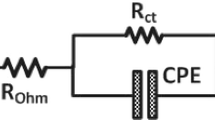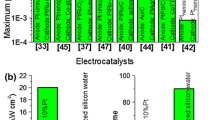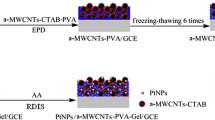Abstract
Fuel cells capable of synthetic glucose catalysis have revolved around the implementation of abiotic catalysts that require extreme acid and alkaline environments. These are not compatible with implantable medical sensor systems, and hence, there is a need to develop abiotic catalysts that operate at neutral pH. This paper presents structural and electrochemical characteristics of a nanoporous electrode designed for abiotic glucose oxidation in the presence of oxygen in neutral physiological media. The electrode was fabricated by annealing e-beam deposited thin films of platinum (Pt) and nickel (Ni) into a Pt–Ni alloy on a silicon substrate. The porous nature of the alloy enhances electrochemical properties by increasing the real surface area ~ 500 times compared to the geometric surface area of as-prepared multilayer thin films. This was reflected in the exchange current density of the electrode annealed at 800 °C being twice that of the electrode annealed at 650 °C. The cell voltage increase, due to the addition of dissolved physiological oxygen of 2 ppm, was about 100 ± 8 mV under a load current density of 2 µA cm−2. After running for 72 h in a physiological saline solution with 5 mM glucose, the increase in the electrode potential was only 23 µV h−1. These results suggest that the nanoporous Pt–Ni alloy anode offers an improved catalytic stability with time and should be a viable candidate for use in abiotic catalyzed glucose fuel cell systems operating under physiological conditions.










Similar content being viewed by others
References
Larsson B et al (2003) Lessons from the first patient with an implanted pacemaker: 1958–2001. PACE 26:114–124
Grayson ACR et al (2004) A BioMEMS review: MEMS technology for physiologically integrated devices. Proc IEEE 92(1):6–21
Wise KD et al (2004) Wireless implantable microsystems: high-density electronic interfaces to the nervous system. Proc IEEE 92(1):76–97
Desai TA et al (1998) Implantation of microfabricated immunoisolating biocapsules. In: proceedings of SPIE, micro- and nanofabricated structures and devices for biomedical environmental applications, vol. 3258, pp. 40–47. International Society for Optics and Photonics
Sbiaa Z (2006) MEMS fabricated chip for an implantable drug delivery device. In: 2006 International conference of the IEEE engineering in medicine and biology society
Birchall J (2006) Microfabricated microneedles for drug and gene delivery to skin. In: 2006 2nd IET seminar on micro/nanotechnology in medicine
Grant SA et al (2001) In vitro and in vivo measurements of ®ber optic and electrochemical sensors to monitor brain tissue pH. Sens Actuators B Chem 72:174–179
Ziaie B, Najafi K (2001) An implantable microsystem for tonometric blood pressure measurement. Biomed Microdevice 3(4):285–292
Krushinitskaya O et al (2009) Novel osmotic sensor for a continuous implantable blood-sugar reader. In: 6th International workshop on wearable, micro, and nano technologies for personalized health (pHealth). IEEE, Oslo
Yang Y, Wei XJ, Liu J (2007) Suitability of a thermoelectric power generator for implantable medical electronic devices. J Phys D Appl Phys 40(18):5790–5800
Lay-Ekuakille A et al (2009) Thermoelectric generator design based on power from body heat for biomedical autonomous devices. In: IEEE international workshop on medical measurements and applications, 2009. MeMeA 2009, pp 1–4
Mitcheson PD et al (2008) Energy harvesting from human and machine motion for wireless electronic devices. Proc IEEE 96(9):1457–1486
Beeby SP, Tudor MJ, White NM (2006) Energy harvesting vibration sources for microsystems applications. Meas Sci Technol 17(12):R175–R195
Nielsen ME et al (2008) Sustainable energy from deep ocean cold seeps. Energy Environ Sci 1(5):584–593
Holmes DE et al (2004) Microbial communities associated with electrodes harvesting electricity from a variety of aquatic sediments. Microb Ecol 48(2):178–190
Ivanov I, Vidakovic-Koch T, Sundmacher K (2010) Recent advances in enzymatic fuel cells: experiments and modeling. Energies 3(4):803–846
Wang H-Y et al (2011) Micro-sized microbial fuel cell: a mini-review. Biores Technol 102(1):235–243
Lovley DR (2006) Microbial fuel cells: novel microbial physiologies and engineering approaches. Curr Opin Biotechnol 17:327–332
Kerzenmacher S et al (2008) Energy harvesting by implantable abiotically catalysed glucose fuel cells. J Power Sources 182:1–17
Kerzenmacher S et al (2011) A potentially implantable glucose fuel cell with Raney-platinum film electrodes for improved hydrolytic and oxidative stability. J Power Sources 196(3):1264–1272
Kerzenmacher S et al (2008) An abiotically catalyzed glucose fuel cell for powering medical implants: reconstructed manufacturing protocol and analysis of performance. J Power Sources 182(1):66–75
Bagotzky VS, Vasilyev YB (1964) Some characteristics of oxidation reactions of organic compounds on platinum electrodes. Electrochim Acta 9(7):869–882
Brouzgou A, Tsiakaras P (2015) Electrocatalysts for glucose electrooxidation reaction: a review. Top Catal 58(18):1311–1327
Adzic RR, Hsiao MW, Yeager EB (1989) Electrochemical oxidation of glucose on single crystal gold surfaces. J Electroanal Chem Interfacial Electrochem 260(2):475–485
Brouzgou A, Podias A, Tsiakaras P (2013) PEMFCs and AEMFCs directly fed with ethanol: a current status comparative review. J Appl Electrochem 43(2):119–136
Parsons R, VanderNoot T (1988) The oxidation of small organic molecules. J Electroanal Chem Interfacial Electrochem 257(1):9–45
Kerzenmacher S et al (2010) Raney-platinum film electrodes for potentially implantable glucose fuel cells. Part 1: nickel-free glucose oxidation anodes. J Power Sources 195(19):6516–6523
Gebhardt U, Rao JR, Richter GJ (1976) A special type of Raney-alloy catalyst used in compact biofuel cells. J Appl Electrochem 6(2):127–134
Oncescu V, Erickson D (2011) A microfabricated low cost enzyme-free glucose fuel cell for powering low-power implantable devices. J Power Sources 196(22):9169–9175
Rapoport BI, Kedzierski JT, Sarpeshkar R (2012) A glucose fuel cell for implantable brain–machine interfaces. PLoS ONE 7(6):e38436
Sree Harsha KS (2006) Principles of vapor deposition of thin films, 1st edn. Elsevier Science, Oxford, p 1176
Do UP et al (2016) Thin film nanoporous electrodes for the selective catalysis of oxygen in abiotically catalysed micro glucose fuel cells. J Mater Sci 51(19):9095–9107. https://doi.org/10.1007/s10853-016-0162-7
Lukaszewski M, Soszko M, Czerwinski A (2016) Electrochemical methods of real surface area determination of noble metal electrodes—an overview. Int J Electrochem Sci 11(6):4442–4469
Rudi S et al (2014) Comparative study of the electrocatalytically active surface areas (ECSAs) of Pt alloy nanoparticles evaluated by H-upd and CO-stripping voltammetry. Electrocatalysis 5(4):408–418
Trasatti S, Petrii OA (1992) Real surface area measurements in electrochemistry. J Electroanal Chem 327(1):353–376
Doyle RL et al (2013) Non-enzymatic glucose oxidation at electrocatalytic metal oxide films. ECS Trans 53(16):1–15
Pasta M et al (2011) Optimizing operating conditions and electrochemical characterization of glucose–gluconate alkaline fuel cells. J Power Sources 196(3):1273–1278
Ernst S, Heitbaum J, Hamann CH (1979) The electrooxidation of glucose in phosphate buffer solutions: part I. Reactivity and kinetics below 350 mV/RHE. J Electroanal Chem Interfacial Electrochem 100(1):173–183
Bevington PR, Robinson DK (1969) Data reduction and error analysis for the physical sciences, 3rd edn. McGraw Hill, New York
Brug GJ et al (1984) The analysis of electrode impedances complicated by the presence of a constant phase element. J Electroanal Chem Interfacial Electrochem 176(1):275–295
Sreemany M, Sen S (2006) Effect of substrate temperature and annealing temperature on the structural, electrical and microstructural properties of thin Pt films by rf magnetron sputtering. Appl Surf Sci 253(5):2739–2746
Derkach V et al (2014) Grain boundary migration and grooving in thin 3-D systems. Acta Mater 65:194–206
Génin FY, Mullins WW, Wynblatt P (1993) The effect of stress on grain boundary grooving. Acta Metall Mater 41(12):3541–3547
Morrison ART, Hosseiny SS, Wüthrich R (2016) Platinum-like oxidation of nickel surfaces by rapidly switching voltage to generate highly active bifunctional catalysts. Electrochem Commun 67:22–25
Fu TR et al (2014) Total hemispherical radiation properties of oxidized nickel at high temperatures. Corros Sci 83:272–280
Hudak EM, Mortimer JT, Martin HB (2010) Platinum for neural stimulation: voltammetry considerations. J Neural Eng 7(2):026005
Cogan SF (2008) Neural stimulation and recording electrodes. Annu Rev Biomed Eng 10(1):275–309
Robblee LS, Rose TL (1990) The electrochemistry of electrical stimulation. In: Annual international conference of the IEEE engineering in medicine and biology society, vol 12, p 1479
Alsabet M, Grden M, Jerkiewicz G (2015) Electrochemical growth of surface oxides on nickel. Part 3: formation of beta-NiOOH in relation to the polarization potential, polarization time, and temperature. Electrocatalysis 6(1):60–71
Mahshid SS et al (2011) Template-based electrodeposition of Pt/Ni nanowires and its catalytic activity towards glucose oxidation. Electrochim Acta 58:551–555
Mahshid SS et al (2012) Preparation of pulse deposited Pt/Ni nanowires electrode for glucose detection in alkaline solution. Int J Theor Appl Nanotechnol 1(1):66–72
Beverskog B, Puigdomenech I (1997) Revised Pourbaix diagrams for nickel at 25–300 °C. Corros Sci 39(5):969–980
Bolzan AE, Iwasita T, Vielstich W (1987) On the electrochemical oxidation of glucose: identification of volatile products by on-line mass spectroscopy. J Electrochem Soc 134(12):3052–3058
Rao JR et al (1976) The performance of glucose electrodes and the characteristics of different biofuel cell constructions. Bioelectrochem Bioenergy 3(1):139–150
Ernst S, Heitbaum J, Hamann CH (1980) The electrooxidation of glucose in phosphate buffer solutions: kintetics and reaction mechanism. Ber Bunsenges Phys Chem 84(1):50–55
de Mele MFL, Videla HA, Arvia AJ (1982) Potentiodynamic study of glucose electro-oxidation at bright platinum electrodes. J Electrochem Soc 129:2207–2213
Yan X, Ge X, Cui S (2011) Pt-decorated nanoporous gold for glucose electrooxidation in neutral and alkaline solutions. Nanoscale Res Lett 6(1):1–6
Becerik I, Ficicioglu F, Kadirgan F (1999) Effect of temperature on the electrochemical oxidation of some organic molecules on Pt doped conducting polymer coated electrodes. Turk J Chem 23:353–360
Habrioux A et al (2007) Activity of platinum–gold alloys for glucose electrooxidation in biofuel cells. J Phys Chem B 111(34):10329–10333
Zahner (2013) Thales manual. In: Thales 04: SIM—simulation and fitting
Vassilyev YB, Khazova OA, Nikolaeva NN (1985) Kinetics and mechanism of glucose electrooxidation on different electrode-catalysts: Part I. Adsorption and oxidation on platinum. J Electroanal Chem Interfacial Electrochem 196(1):105–125
de Mele MFL, Videla HA, Arvía AJ (1983) The electrooxidation of glucose on platinum electrodes in buffered media. Bioelectrochem Bioenergy 10(2):239–249
Pajkossy T, Kolb DM (2001) Double layer capacitance of Pt(111) single crystal electrodes. Electrochim Acta 46(20):3063–3071
Pell WG, Zolfaghari A, Conway BE (2002) Capacitance of the double-layer at polycrystalline Pt electrodes bearing a surface-oxide film. J Electroanal Chem 532(1):13–23
Rosen M, Flinn DR, Schuldiner S (1969) Double layer capacitance on platinum in 1 M H2SO4 from the reversible hydrogen potential to the oxygen formation region. J Electrochem Soc 116(8):1112–1116
Lam CM (2000) Glucose oxidation on different electrocatalysis: mechanism and sensor applications. The University of Hong Kong, Hong Kong
Chen C-C, Chen L-C (2015) Synthesis and characterization of Pd–Ni core–shell nanocatalysts for alkaline glucose electrooxidation. RSC Adv 5:53333–53339
Acknowledgements
The authors would like to thank technical staff and colleagues at the University of South-Eastern Norway (USN) for their assistance in this work. The work was supported by the Norwegian Ph.D. Network on Nanotechnology for Microsystems, Norfab (Project: 245963), The Norwegian Centre for International Cooperation in Higher Education (SIU), The Ministry of Church and Education and The Research Council of Norway.
Author information
Authors and Affiliations
Corresponding author
Additional information
Publisher's Note
Springer Nature remains neutral with regard to jurisdictional claims in published maps and institutional affiliations.
Rights and permissions
About this article
Cite this article
Do, U.P., Seland, F., Wang, K. et al. Raney-platinum thin film electrodes for the catalysis of glucose in abiotically catalyzed micro-glucose fuel cells. J Mater Sci 54, 14143–14156 (2019). https://doi.org/10.1007/s10853-019-03907-9
Received:
Accepted:
Published:
Issue Date:
DOI: https://doi.org/10.1007/s10853-019-03907-9




